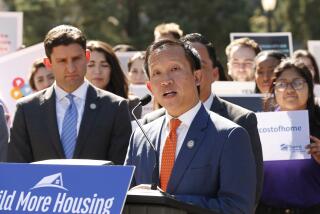War Schism Lingers as S.F. Is Split Over Parade : Controversy: Business and veterans groups remain bitter that city declared itself sanctuary for conscientious objectors.
- Share via
SAN FRANCISCO — Like scores of other military parades planned for Armed Forces Day on Saturday, the one curving along this city’s waterfront will see cheering crowds, bands marching over frills of confetti and aircraft thundering overhead.
Behind the scenes, however, a streak of contention sets this event apart from others. Bad feelings linger from a sanctuary measure the Board of Supervisors passed in January to protect conscientious war objectors, and threats of protests overshadow the festivities.
Ever since the first shots rang out over the Arabian sands, the supervisors have been embroiled in a conflict that some say rivals the bitterness of the Gulf War itself. The board found itself on the defensive against a barrage of criticism from Mayor Art Agnos, thecity’s Chamber of Commerce and veteran’s groups, who launched attacks against the supervisors in newspaper ads, editorials and press conferences.
Despite promises of boycotts against the city and a battle with critics that outlasted the Gulf War, the sanctuary resolution has survived.
“San Francisco has deserted us,” said Jack Bergess, a senior vice commander for the Veterans of Foreign Wars chapter, who intends to roll through the parade in his wheelchair. “You can’t support the troops, as the Board of Supervisors say they do, and still have the city as a sanctuary.”
Not so, said Supervisor Harry Britt, who sponsored the sanctuary measure and insists a parade is an appropriate way to show the city’s appreciation for the military. “When the nation is in a state of patriotic fervor, you have to protect the civil rights of conscientious objectors,” he said.
Because the Board of Supervisors is offering the city as a haven for war resisters, though, the Convention and Visitors bureau and the Chamber of Commerce contend San Francisco may have lost millions of dollars in trade and convention business.
Parade organizers and city officials are trying to revive San Francisco’s tarnished reputation by replacing the city’s trademark television images of war demonstrations with those of triumphant soldiers marching through the streets.
At risk of losing more than $30 million in convention business, the Chamber of Commerce bought advertisements in national and local newspapers accusing City Hall of being “out of sync” with public opinion last March. Set against a patriotic red-white-and-blue backdrop, the ads urged the supervisors to repeal the sanctuary measure. They did not.
Soon after the war ended, the Army suggested staging a parade through the city when the troops returned. Two days after the Chamber of Commerce’s ad blitz, Agnos announced that the city would host a parade. Agnos also vetoed a measure by the Board of Supervisors to reaffirm the city’s sanctuary status.
But San Francisco’s plans quietly changed over the past few weeks. Organizers initially said they wanted to march a convoy of returning soldiers down Market Street in what they were calling a “Victory Parade.” As the date drew closer, though, the location was switched to a less conspicuous area near the Presidio.
The new route lends itself to an air show, and its proximity to the waterfront would allow ships to participate in the festivities, planners said. The Veterans of Foreign Wars, however, said the parade path was changed after they threatened to boycott a procession down Market Street. Parading through the heart of a city that protects deserters is an insult to veterans, a spokesman for the group said.
At least two other groups--the Bay Area Religious Peace Action and the Emergency Committee to Stop the War in the Middle East--also are offended by the parade, for different reasons.
“What happened in the Middle East wasn’t war, it was a high-tech slaughter,” said Richard Becker, who is coordinating a protest of Saturday’s parade. “We’re not against the rank-and-file GIs. . . . We just think we shouldn’t glorify the massacre.”
More to Read
Sign up for Essential California
The most important California stories and recommendations in your inbox every morning.
You may occasionally receive promotional content from the Los Angeles Times.













